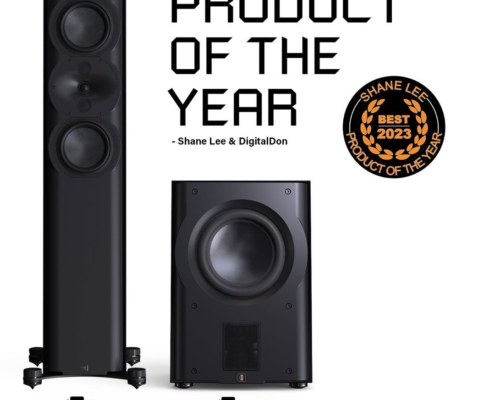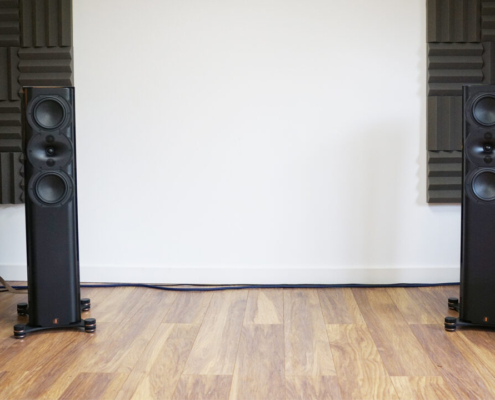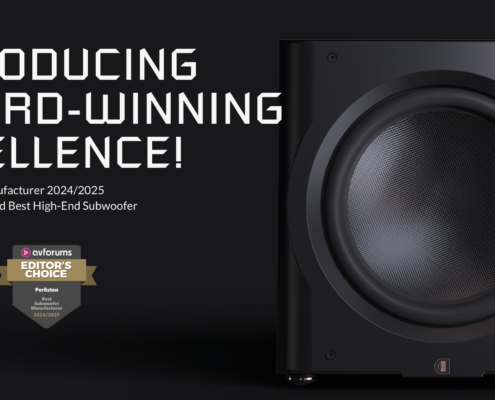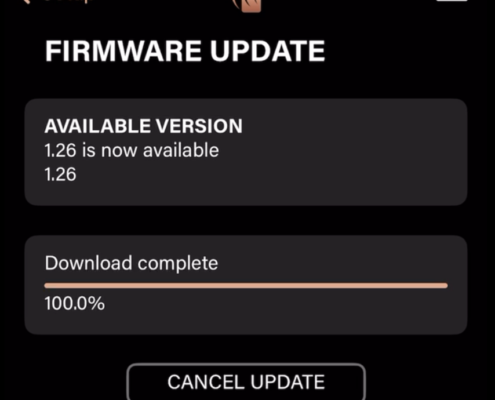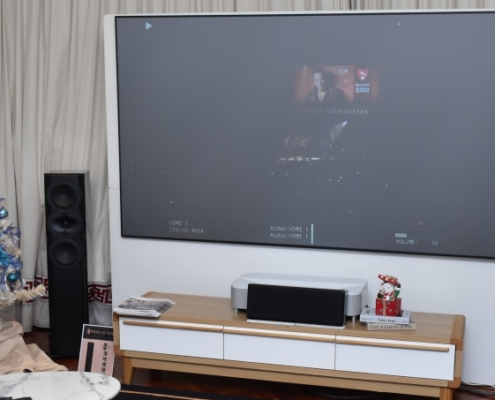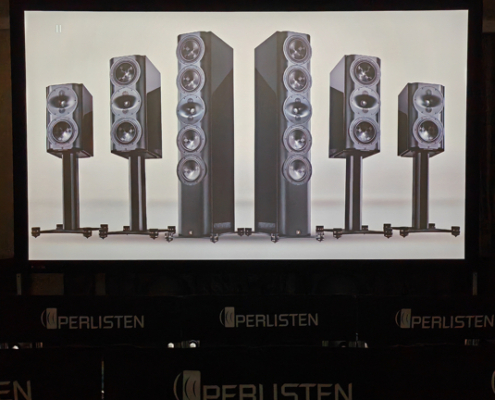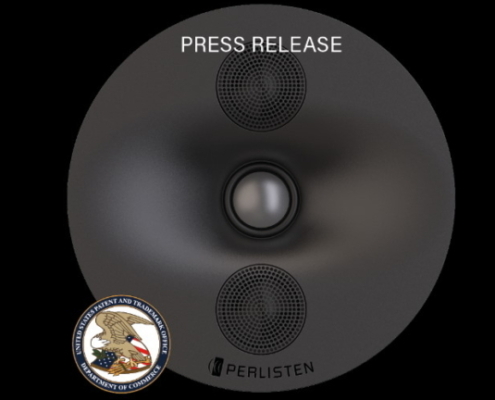[器評] 瑞典PRIMARE PRE35 Prisma 美國Stereophile權威雜誌2024最佳推薦
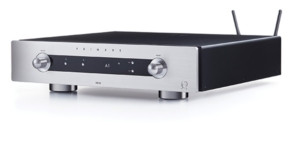
在考慮 Primare PRE35 Prisma 前置擴大機時,Hygge 可能不是第一個想到的字眼,但在瑞典 Limhamn,Primare 就喜歡這樣形容他們的產品。它的意思是「舒適」,在北歐國家是非常重要的概念,幾乎是一種生活方式。另一個出現在 Primare 產品描述中的詞彙是 lagom,粗略地翻譯成「不太少、不太多–恰到好處」。
對我來說,這些都沒有在翻譯中遺失。我很喜歡高科技設備的民間形容詞。在與全新 PRE35 Prisma 前置放大器共度 hygge 時光之後,我將 hygge 等同於「不像數位聲音」,而 lagom 則等同於其優雅的實體與電子設計:不太少,也不太多。
以現代的高保真標準來看,Primare 已經有一段時間的歷史了。由 Bo Christensen 和 Bent Nielsen 於 1985 年在瑞典創立,Primare 採用團隊方式進行研發: 專業人員負責設計的不同技術層面,Primare 的總工程師 Nielsen 則負責整合一切。Primare 是 D 類擴大的早期採用者;我的同事 Kal Rubinson 和 Herb Reichert 都在最近的 Primare 擴大機評論中探討過這方面的問題 (註腳 1)。此外,Primare 在探索數位音訊儲存與串流技術方面也是眾所皆知的先驅,而 PRE35 Prisma 也完全實現了這些功能。
了解更多:美國Stereophile權威雜誌2024最佳推薦

插孔、旋鈕與電路板
在不把這篇評論變成使用手冊的情況下,以下是可用輸入和輸出的簡要摘要:五個類比輸入(兩對平衡)、九個數位輸入(四個 TosLink、兩個 RCA 上的 S/PDIF、一個 USB-A、一個 USB-B、一個 LAN/乙太網路)、Wi-Fi 和藍牙天線、兩個平衡和兩個非平衡輸出(包括一個 RCA 上的線路直通)、一個數位輸出(RCA 上的 S/PDIF)和一個 LAN 輸出。此外,機上還有常用的觸發器連接埠和 RS-232 用於整合。奇怪的是,在如此多的連接選項中,竟然沒有我喜歡的 AES3 數位輸入,也沒有耳機插孔。在類比方面,平衡訊號從輸入到輸出都是完全平衡且完全類比的。
PRE35 Prisma 是經典的單架式裝置,高 4.2 吋,有三個高品質、可旋轉至水平的腳座。PRE35 Prisma 運行溫度低,可與其他元件堆疊使用。前面板很簡單,有兩個大型多功能旋鈕和四個小按鈕;前面板的功能與隨附的遙控器相同。相對較小的顯示器提供基本的狀態資訊。如果這些年來我的直覺是對的,音訊元件上的旋鈕手感就是其品質的線索,那麼 PRE35 就是最高品質的音訊元件: 其厚重的金屬機殼與堅固的旋鈕相得益彰。Primare 可能在中國製造,但卻在瑞典設計。
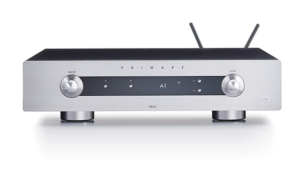
為了比手冊和網站更全面地瞭解 PRE35 Prisma,我向 Primare 的行銷經理 Terry Medalen 求助。他告訴我,PRE35 Prisma 的線性電源使用客製化繞線的 R-core 變壓器,並採用切換模式,僅供待機使用;它會切換至線性電源。Primare 非常重視他們的電源供應器: 在 PRE35 Prisma 的「設計簡介」中,「徹底實現的電源設計」是列在第一項的項目。
這是一款前級放大器,因此音量控制非常重要。Medalen 解釋說,這裡的是一個「2 × 4 聲道平衡模式 IC,選用來達到最佳的聲道平衡和低聆聽電平效能 – IC 完全不在訊號路徑中。它在 21 到 54 之間以 1dB 的增量運作(在前面板讀出),在 55 到 99 之間以 0.5dB 的步驟運作。
音量控制、內部 DAC 和網路電子元件可能會產生雜訊問題;PRE35 Prisma 藉由短電路路徑、謹慎的電路實作、使用四層電路板 (其中一層作為地線) 和表面貼裝元件來解決這個問題,這些元件所扮演的天線角色比較傳統的大型元件還要小。
PRE35 DAC 以 AKM 旗艦 DAC 晶片 AK4497EQ 為基礎。據說此晶片「能達到 128dB (立體聲) S/N 和 -116dB THD+N,同時支援高達 768kHz PCM 和 22.4MHz DSD。這種處理更高解析度檔案格式的能力將允許未來軟體升級的潛力,」根據設計概要。AK4497EQ 還包括「新開發的切換式電容濾波器 ‘OSR Doubler’,可大幅降低雜訊整形所造成的音質劣化,實現高達 200kHz 的平坦本底雜訊」。
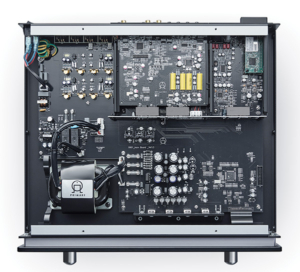
建立連結
高品質音訊設備的消費者與設計師都面臨一系列新的挑戰,因為無論好壞,硬體與軟體已成為需要相互考量的夥伴。音響公司現在必須僱用軟體設計師或與軟體設計師合作,而我們也必須學習如何使用這些合作的成果,包括應用程式整合和不斷發展的功能集。在我評測 PRE35 Prisma 的過程中,有許多硬體/軟體的結合仍在進行中,尚未完成。Terry Medalen 向我匯報了 Primare 目前與未來的一些合作計畫。軟體可透過網路連線進行線上更新。
• PRE35 Prisma 係設計用來控制多房間訊號的 Primare Prisma 應用程式,此應用程式適用於 iOS 和 Android。目前,該應用程式有助於組件設定、整合網路收音機、允許存取本機網路中儲存的音樂檔案,並提供連結,讓您可以透過 Chromecast、AirPlay、藍牙和 Spotify Connect 連線存取本機串流服務 – 但請參閱下文。
• 在未來幾個月內,Qobuz 和 Tidal 將會整合到 Prisma 應用程式中,允許使用這兩項服務進行無間隙播放。一旦實現,Qobuz 將提供高達 24/192 的無間隙播放,而 Tidal 則支援 48、88.2 或 96kHz 的無間隙播放和 MQA 解碼至第一個完整展開。
• 在測試時,Roon 依賴 AirPlay 或 Chromecast 與 PRE35 連線,解析度限制為 16/44.1 (AirPlay) 或 24/96 (Chromecast)。不過,韌體將於三月更新,也就是您閱讀這篇文章的時間,屆時將採用 Roon 的工業級串流協定 RaaT,其目的是支援「現在與未來所有相關的音訊格式」,無論是有線或無線。屆時,PRE35 將被認證為 「Roon Ready」。
• 一旦 Tidal 與 Prisma 應用程式完全整合 (同時也與 Roon 整合),Tidal Connect 與即將推出的 Qobuz Connect 將變得多餘,因此將不支援它們。
• Primare 對藍牙的處理方式不同尋常。他們意識到目前所有藍牙實作的限制,因此使用較舊版本 (Bluetooth 4.1 及其基本 SBC 編解碼器) 的配置,並針對休閒聆聽進行最佳化。想要更好的音效?選擇更好的連接。
• PRE35 支援 WiSA 連線至無線喇叭,這是一項有趣的未來預測。WiSA 支援高達 24/96 的連線,延遲近乎零,揚聲器同步時間可達一微秒。根據研究,這遠低於人類辨別的臨界值。
起初,我依靠筆記型電腦與 Wi-Fi 連線,並使用 USB 傳輸線連接 PRE35 Prisma。後來,我用乙太網路線將路由器直接連接到 Primare。我也嘗試了 Wi-Fi 連線,效果還不錯,但我所有認真的聆聽都是使用乙太網路連線。
設定時,我坐得很近,戴著老花眼鏡,因為如我所說,PRE35 Prisma 的顯示器相當小。設定可分為五個類別 – 一般、輸入、音訊、串流和網路 – 包括自訂待機狀態、啟動時的音量、最大音量和輸入增益。甚至連靜音也可以調整:從 0 到您選擇的任何設定。
更上層樓
我有三套獨立的音響系統,分為三種價格等級。這樣我就可以將正在評測的元件引入到匹配的系統中,讓元件和諧互補,音樂感十足。
我一直稱之為我的參考系統,現在我稱之為樓上系統。這套系統是圍繞 Wilson Audio Sasha DAWs(我曾在 2019 年 12 月評測過)建立的,由強大的 McIntosh MC462 固態立體聲擴大機驅動,我曾在 2019 年 4 月評測過。唱頭級和前級放大器都是真空管,來自 Audio Research。樓上的系統是我開始試聽 Primare PRE35 Prisma 作為前級放大器的地方,使用我的外接 CD 播放器作為音源。
我喜歡評測過程中的許多方面,其中之一就是有機會重新聆聽錄音,這些錄音我可能已經有一段時間沒有聽過了,往往會發現以前被新元件所隱藏的元素。

為了開始探索 PRE35 Prisma 作為前級放大器的音質特性,我聆聽了 Burt Bacharach 2005 年的專輯 At This Time(CD,Columbia/Sony CK 97734)。這張專輯的知名度不及 Burt Bacharach 的許多其他作品,但卻是 Bacharach 睽違七年後的首張專輯。在此期間,發生了 9/11 事件;現在聽來,這張專輯似乎比之前的專輯更黑暗、更政治化。有些節奏來自 Dr. Dre。
對於這張專輯的錄音,我有個人的聲音參考框架: 我曾在 Capitol Records Studio A 的錄音室作客,當時 Bacharach 在幾首曲子中加入了弦樂管弦樂團,包括器樂作品「Danger」,在黑暗、低沉的 Dre 合成器迴圈中,刺耳的弦樂聲忽隱忽現。
我的印象是 PRE35 Prisma 的聲音非常接近我的參考 Audio Research REF6SE 前置擴大機,但又不完全一樣。深沉的低音在 PRE35 上比較前,最高的高音我聽起來比較亮–換句話說,在極端部分的聲音有點不同。一開始,我覺得不太舒服。

回想起眾所皆知的燒機現象–Primare 表示其產品在播放 24 小時後音效最佳。隨著時間的推移,不是它的聲音特徵改變了,就是我適應了它。在最新的 Records to Live For 中,我選擇了 Frank Sinatra 的 Capitol 年代專輯。我還發現了另一張很棒的專輯,類似但不同: Frank Sinatra: The Complete Capitol Singles Collection (16/44.1 FLAC, Capitol Records/Qobuz)。我了解到,這些單曲版本與專輯中相同的歌曲不同。當我聆聽這些歌曲時,PRE35 Prisma 的聲音渾然天成。之前看起來過度飽滿的低音,現在則是深沉平靜的海洋,讓 Frank 的歌聲揚帆起航。
我拿出另一張有一陣子沒聽過的 CD,那是 2009 年電影《阿凡達》(Atlantic 521681)的原聲大碟,由已故的 James Horner 所製作。有了 PRE35,開場曲目「You Don’t Dream in Cryo」中隆隆作響的低沉嗚咽,有著令人印象深刻的電影般的厚重感,比我的參考前級放大器還要強勁。管弦樂的紋理和人聲既不單薄也不刺耳;我聽到的細膩細節增強了這個高度複雜的多聲道錄音。
樓下
在我現在的房子裡,我第一次在客廳組裝了一套高品質的系統。這套系統是以經典的 McIntosh MC275 真空管擴大機為基礎,驅動 Alan Shaw 最新版的雙向立式喇叭 Harbeth C7ES-3 XD。我很想聽聽這套固態/真空管組合會有多好的表現。在樓下,我使用 Primare 的全部功能作為串流 DAC/前級放大器,音樂來自 Qobuz。

Stephen Sondheim 的偉大音樂劇《Into the Woods》(24/48,Craft Recordings/Qobuz)的 2022 年百老匯演員錄音版獲得了我的格萊美年度最佳音樂劇專輯投票–很容易的選擇。Sondheim 複雜、急促的歌詞需要高品質的重播: 所有這些瞬間的輔音和持續的旋律元音都必須聽得清清楚楚,才能充分欣賞其藝術性。歌詞清晰如铙钹,現場管弦樂團聽起來精力充沛,但絕不刺耳–事實上,比一般的擴音現場百老匯演出還要好。
Samara Joy 是我很久以來聽過最有趣的年輕爵士樂手之一。她的首張同名專輯(24/96 FLAC,Whirlwind Recordings/Qobuz)涵蓋了「But Beautiful」和「Everything Happens to Me」等標準曲目,並展現了她精準的嗓音,在歌詞需要的時候,她的嗓音可以相當陰沉,但卻不沉重或厚重。Joy 不畏懼踏入 Ella 的領域,而且她的聲音、技巧和音樂成熟度都足以做到這一點。對於這種音樂,PRE35 Prisma/MC275 的搭配非常合適,提供灼熱的音色和精確的影像。
註腳 1: 請參閱 Herb Reichert 於 2020 年 4 月對 Primare A35.2 功率放大器的評測,此處;以及 Kalman Rubinson 於 2022 年 11 月對 A35.8 功率放大器的評測,此處。
閱讀原文:原文連結
了解更多:產品介紹
技術服務諮詢
M&K Sound台灣總代理 愷銳音響 台北總公司
地址:台北市信義區信義路六段22號2樓 | 電話:02-2726-1286
台中展示中心
地址:台中市西屯區台灣大道三段709號 | 電話:04-2258-1918

